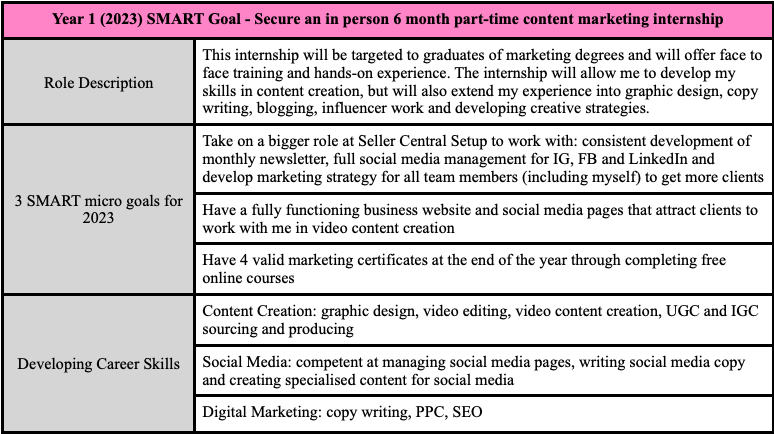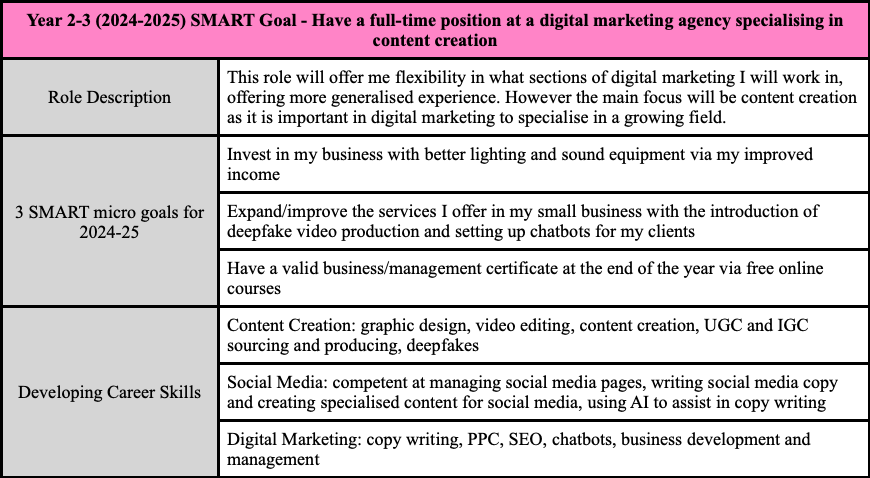This post is the creation of my 5 year career plan in digital media marketing as informed by my previous blog posts. To learn more about this project, please go here.
Over the last few blog posts, I have been researching the digital media marketing field in order to create a future studies informed five-year plan that addresses my short to medium term career future. In my first blog, I made a five-year plan prior to conducting any research to demonstrate the value of future studies research within this blog post.
Indeed, within this blog, I will relay my research on how to create a five-year career plan and offer my useful template filled out with my career plan as an example. This post can be used as a guide for students, especially those wanting to enter the marketing field and are interested in creating their own 5-year plan.
HOW TO MAKE A 5 YEAR CAREER PLAN (with example)
A 5-year career plan illustrates professional goals that individuals wish to achieve within the next five years. Career plans often include long term and short term goals that are used as an actionable checklist to help people achieve their professional desires. 5-year plans significantly increase the likelihood of individuals staying accountable in achieving their goals, offering clarity and a sense of professional direction. Further, 5-year plans force individuals to set specific and measurable goals that ensure an individual is working towards what they would like to achieve within a specified period.
Erin Delaney, a careers commentator, suggests utilising the SMART (Specific, Measurable, Actionable, Realistic, Time-Bound) goal-setting method to create a successful career-planning tool. Delaney says that there are four steps to creating this 5-year plan, so let’s go through the steps while using my career goals as an example:
Step One: Set Your Macro Goal
This goal should be the ultimate goal you want to achieve by writing this plan, offering direction for the rest of the template and giving the resulting micro-goals purpose and meaning. Here is my macro goal:
“In 5 years, I will be a digital marketing manager at a thriving corporation on a full-time salary of 110k per year with a successful side business for a second income stream.”
Step Two: Set Your Micro Goals
This step focuses on where you are now and considers all the steps you need to take to achieve your end goal. To do this, I wrote a separate blog providing a detailed analysis of my current career status, which you can read here. Setting incremental micro-goals that reflect a good measurement of progress towards your aim are important to make you recognise your continued progression. Here are some micro-goals I have developed in considering my macro goal and my future studies research on the future of digital media marketing (which you can read here):
- Get hired at an internship that expands my professional experience (e.g. graphic design, copywriting, etc.)
- Take on a bigger role at SCS by working more hours
- Set up my small business website and social media
- Invest in better content creation equipment
- Get hired in a full-time content creation role
To see my full list of SMART micro-goals, see my five-year career template within this blog post below.
Step Three: Make Your Goals Attainable and Realistic
Making sure the goals you set are attainable and realistic is essential; otherwise, you run the risk of demoralising yourself. Consider the time frame of five years and set realistic achievements for the short to medium-term future. For example, it would be unattainable for me to set my goal as ‘becoming the CEO of a digital agency’ within five years. Instead, goals such as ‘having a full time position as a content creator specialist’ are far more realistic, with a clear objective path.
Step Four: Make Your Goals Time-Bound
It may be helpful to give yourself a certain timeframe to complete each micro goal to ensure you stay on track and motivated in your career plan. Consider not giving yourself too much or too little time to accomplish a task, as either way can result in you ultimately giving up.
For example, my career plan shows that by the end of 2023, I want to have completed four marketing certificates via online courses. To achieve this, I can set a time frame for completing a certificate every three months in 2023 to reach my goal.
Career Plan Example
Most 5-year career plan templates do not encompass these SMART steps in a useable format. From my research on 5-year plans, I was able to create the following actionable guide for me to use over the next five years, allowing for the possibility of a change in direction.
This template is split into year 1, years 2-3, and years 4-5 as a general guide to offer me specific direction. Each section has an overarching SMART goal, including the description of my desired role and 3 SMART micro-goals. Finally, the template includes a list of what career skills I wish to develop each year, informed by my previous blog post that explored the future of content creation, social media and digital marketing.



HOW MY FUTURE STUDIES INFORMED MY NEW 5 YEAR PLAN
In my first blog post of this series (see here), I created a five-year career plan without researching the chosen industry I wanted to enter and had zero knowledge of how to create a five-year plan. In this section, I want to discuss how the research I have since conducted has greatly improved my understanding of the digital marketing industry and my subsequent career direction, as shown in my plan.
ACTIONS vs GOALS
In my first career plan, I set goals for each year with accompanying actions offering descriptions of the results of said actions. By setting up actions rather than goals, my first career plan provided no room for development outside of my selected goals. My future studies research taught me that the marketing industry could go in many different ways, so I should prepare for career redirections and flexibility. By identifying an overarching goal and three micro goals for each 1-2 years, I have been able to give myself the ability to change as the industry changes.
GOALS AND SKILLS
While creating my first five-year career plan, I could not identify the industry-specific skills I needed to develop to achieve my long-term goals. My updated plan clearly demonstrates a better sense of direction and guidance by separating the specific skills I would like to focus on.
These skills were identified through researching the future of digital media marketing, which you can read here. Indeed, my future studies research helped me identify the growing sectors of the marketing industry, including artificial intelligence, video content creation and SEO. This future studies research allowed me to understand what skills I will need to improve upon to remain a competitive worker within the industry and ultimately achieve my goals. My future studies research is evidently reflected in my five-year career plan in the ‘Developing Career Skills’ sections.
CONCLUSION
By utilising futurology through this project, I have been able to gain a stronger practical understanding of the digital marketing field. This research has helped me establish a deeper continuity of my imagined experience, as shown in creating an informed five-year career plan. The progression of this project has acted as a practical demonstration of the value of conducting futurist research while exploring alternate futures, possible imagined futures within the digital Anthropocene and the novum future of digital media marketing. Not only has this project helped me develop a sense of understanding for the direction of my future, but I have also framed this project as a guide for students wishing to develop their own career plans.
I really hope you have enjoyed reading this series.
Thanks so much for reading, and remember to Keep it Sweet!
2 thoughts on “Da Blog Post 3: My Informed 5-Year Career Plan”